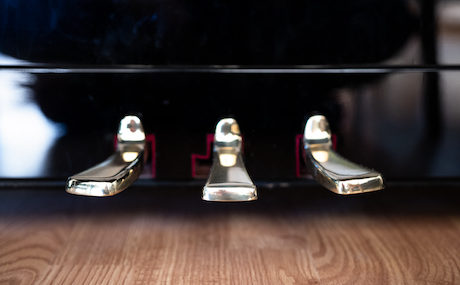Playing the piano requires more than just hitting the right keys. Proper technique is essential to producing a beautiful sound and avoiding injury.
Have you ever considered the importance of pedaling when playing the piano? Proper pedaling technique is often overlooked.
The piano pedals can significantly alter the sound and character of a piece of music. However, using the pedals incorrectly can result in a muddy or indistinct sound. So what is proper pedaling technique on the piano? How do you master it?
Before we get to a few tips, let’s explore the different types of pedals found on a piano.
Most pianos will have two or three pedals, depending on the make and model of the instrument. The right pedal, also known as the sustain pedal, is the most commonly used. It is located on the right side of the piano and is operated with the right foot. The sustain pedal prolongs the sound of a note or chord. When the sustain pedal is pressed down, it lifts the dampers off the strings, allowing them to vibrate freely. This creates a more resonant and full-bodied sound.
The left pedal, also known as the soft pedal or una corda pedal, is located on the left side of the piano and is operated with the left foot. The soft pedal is used to create a softer, more delicate sound. When the soft pedal is pressed down, it moves the entire piano action slightly to the right, causing the hammers to strike only one or two strings instead of three. This results in a softer and more muted sound.
The middle pedal, also known as the sostenuto pedal, is less common and is usually only found on higher-end pianos. It is located in the middle of the piano and is operated with the right foot. The sostenuto pedal is used to sustain only selected notes while the other notes are played staccato.
Now that we have a basic understanding of the pedals on a piano, let’s discuss some tips for proper pedaling techniques.
Listen carefully
When you first start playing, you focus on mastering the notes and creating the song. The more you practice, the more you’ll get into refining your sound. That’s where the pedals come into play. Listen carefully to the sound you are producing. Pedaling is not just about pressing down on the pedal; it is about creating a specific sound. Pay attention to how the sound changes as you press down on the pedal and release it. Listen for any muddiness or blurring in the sound, and adjust your pedaling accordingly.
Use the sustain pedal sparingly
The sustain pedal should be used sparingly, particularly in faster and more complex pieces. Overusing the sustain pedal can result in a muddy and indistinct sound. Instead, use the pedal to create specific effects or to connect notes that would be difficult to play legato. Remember, the pedal is a tool, not a crutch.
Lift the pedal between notes
One common mistake when using the sustain pedal is failing to lift it between notes. Lifting the pedal briefly between notes helps to create a clean and distinct sound. Practice lifting the pedal quickly and lightly, almost as if flicking it with your foot.
Use the soft pedal judiciously
The soft pedal should also be used sparingly. It is not meant to be used all the time, but rather to create a specific effect. The soft pedal can be particularly effective in slower and more expressive pieces, requiring a delicate touch.
Practice with each pedal separately
To master pedaling technique, practicing with each pedal separately is essential. This allows you to focus on each pedal’s specific effect and develop a more nuanced and expressive sound.
Are you ready to add pedaling techniques into your regular practice? Proper pedaling technique is essential to producing a beautiful and expressive sound on the piano. Remember to listen carefully, use the pedals sparingly, and continue to practice with each pedal separately.
Have fun!


